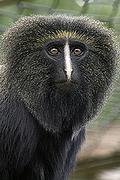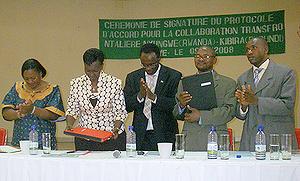 數十年來深陷種族爭戰敵對中的非洲鄰國盧安達和蒲隆地,最近因為共同簽署保護東非最大的山地森林保留區而站到同一陣線上。這塊森林保留區是黑猩猩、梟面猴等瀕危靈長類的棲地,也孕育著許多獨一無二的物種。
數十年來深陷種族爭戰敵對中的非洲鄰國盧安達和蒲隆地,最近因為共同簽署保護東非最大的山地森林保留區而站到同一陣線上。這塊森林保留區是黑猩猩、梟面猴等瀕危靈長類的棲地,也孕育著許多獨一無二的物種。
此合作案的成立,是由總部在美國紐約的野生動物保育協會(Wildlife Conservation Society)促成的,兩國10日在盧安達的胡依市(Huye)簽署了這份協定。
野生動物保育協會理事長暨執行長桑德森(Dr. Steven Sanderson)表示:「盧安達和蒲隆地的合作非常值得讚揚,他們聯手捍衛保育這片孕育著共有危脆物種的土地。」「雖然劃定共同保留區是個大挑戰,卻也是以特定區域以及國際規模來保衛野生生物的好機會,蒲隆地和盧安達顯然開創了東非國際合作的佳例。」
此項協定的宗旨為提升盧安達Nyungwe國家公園與蒲隆地Kibira國家公園組成的「Nyungwe-Kibira 風景區」的保育,確保這片連通保護區內的物種至少能自由遊走於兩座公園間。
長久以來Nyungwe-Kibira風景區面臨著盜伐竹林與樹木以及盜採金礦與鈳鉭合金礦(coltan)的威脅。其中鈳鉭合金可提煉出鉭礦,作為電子耗材產品手機、DVD播放機與電腦裡的電容。
日益嚴重的資源盜採破壞,讓兩國政府決定將過去討論多次的連通保護區議題付諸實行,藉由簽署正式協定來保護風景區。
 在簽署儀會上,盧安達旅遊與國家公園事務處總長盧甘巴(Rosette Chantal Rugamba)表示:「這項重大簽署將使我們共同合力遏阻因長久以來欠缺協調觀點及策略所造成風景區的整合弊端。」蒲隆地環境與自然保育國家機構總長阿德林(Ntungumburanye Adelin)也表示:「好不容易我們終於達成這項協定,不過這只是大工程的開始,重要的是接下來還有更多事待完成。」
在簽署儀會上,盧安達旅遊與國家公園事務處總長盧甘巴(Rosette Chantal Rugamba)表示:「這項重大簽署將使我們共同合力遏阻因長久以來欠缺協調觀點及策略所造成風景區的整合弊端。」蒲隆地環境與自然保育國家機構總長阿德林(Ntungumburanye Adelin)也表示:「好不容易我們終於達成這項協定,不過這只是大工程的開始,重要的是接下來還有更多事待完成。」
這次協定的促成者──是野生動物保育協會,是一個設立在紐約布朗克斯動物園(Bronx Zoo)的全球性保育團體。 桑德森表示此協定將促進兩國更深層的合作,也能確保維持野生生物議題上長遠的對話關係。
維持合作關係是十分重要的,因為Nyungwe-Kibira風景區位於東非艾比丁裂谷(Albertine Rift)上,這條縱亙非洲高山群的山谷網絡串連起烏干達、盧安達、剛果共和國、蒲隆地與坦薩尼亞等國的領土,孕育著全球最豐富的野生生物物種。裂谷區因此被視為最重要的保育場域,自1950年代起,野生生物保育協會就展開艾比丁裂谷區的保育提升工作並設劃國家公園,這些計畫由麥克阿瑟基金會(MacArthur Foundation)以及美國漁業暨野生動物局(U.S. Fish and Wildlife Service)贊助。
The two African nations of Rwanda and Burundi, enmeshed in tribal killings for decades, have signed an agreement to safeguard the largest remaining block of mountain forest in East Africa. The area is inhabited by endangered primates such as chimpanzees, rare owl-faced monkeys, and other species found nowhere else on Earth.
The New York-based Wildlife Conservation Society facilitated the agreement, which was signed in Huye, Rwanda on September 10.
"We commend Rwanda and Burundi for collaborating to protect and conserve these vulnerable species, which both nations have the privilege to share," said Dr. Steven Sanderson, president and chief executive of the Wildlife Conservation Society.
"Trans-boundary conservation offers unique challenges, but also unique opportunities to safeguard wildlife on a regional, international scale," he said. "Burundi and Rwanda are clearly leading the way in Eastern Africa on this front."
The agreement is intended to help improve conservation in Rwanda's Nyungwe National Park and Burundi's Kibira National Park.
The two parks, known as the Nyungwe-Kibira Landscape, form a single protected area shared by both nations.
Most species move freely between the parks, underscoring the need for trans-boundary collaboration.
The landscape is increasingly threatened by illegal harvesting of bamboo and timber, along with mining of gold and coltan. A derivative of coltan is used in consumer electronics products such as cell phones, DVD players, and computers.
Authorities of Rwanda and Burundi have informally discussed these issues for some time, but until now, there have been no formal agreements to protect the greater Nyungwe-Kibira Landscape.
At the signing ceremony, Rosette Chantal Rugamba, director general for Rwanda's Office of Tourism and National Parks, said, "The event is a great achievement that will allow us to lessen threats that have been undermining the integrity of the landscape for ages due to lack of concerted vision and strategies."
Ntungumburanye Adelin, director general of Burundi's National Institute for the Environment and Conservation of Nature, said, "It has taken long to reach today's event. But this signature is the only beginning of a long journey, as there is much more to be done."
The agreement is the result of years of work by the Wildlife Conservation Society, a global conservation organization based at New York's Bronx Zoo.
Dr. Sanderson says the signed agreement will accelerate collaboration to a much higher level and will help guarantee the long-term conservation of the region and its wildlife.
According to the Wildlife Conservation Society, the Nyungwe-Kibira Landscape is inhabited by more wildlife species than anywhere else in the Albertine Rift - a network of valleys in Uganda, Rwanda, Democratic Republic of Congo, Burundi and Tanzania that lie alongside some of Africa's largest mountain ranges.
The rift itself is considered one of Africa's most important areas for conservation.
Supported by the MacArthur Foundation and the U.S. Fish and Wildlife Service, the Wildlife Conservation Society has been working in the Albertine Rift since the 1950s to advance conservation and establishment of national parks.




